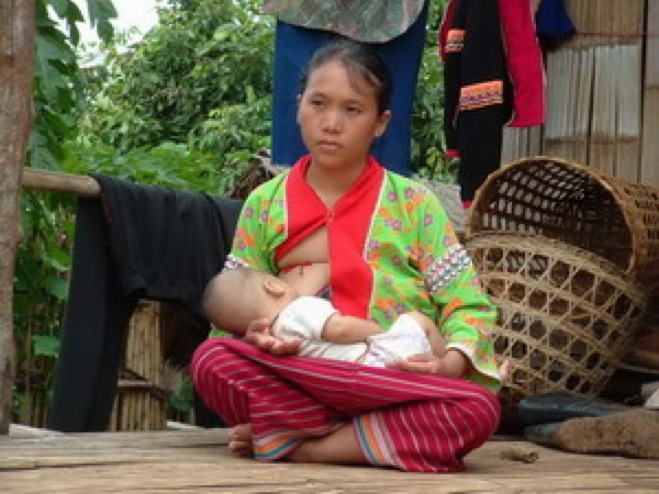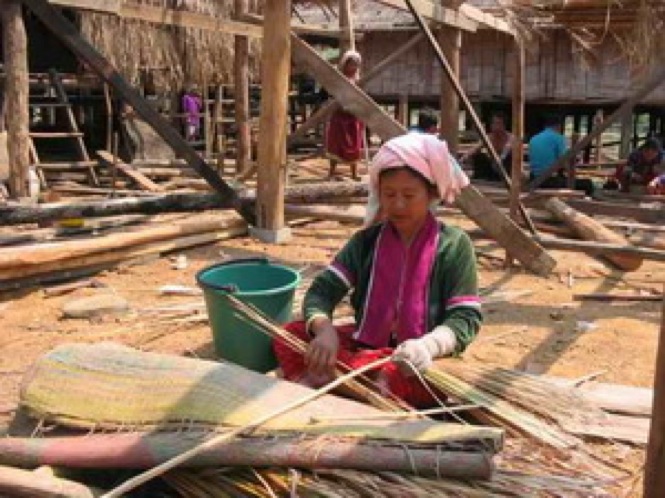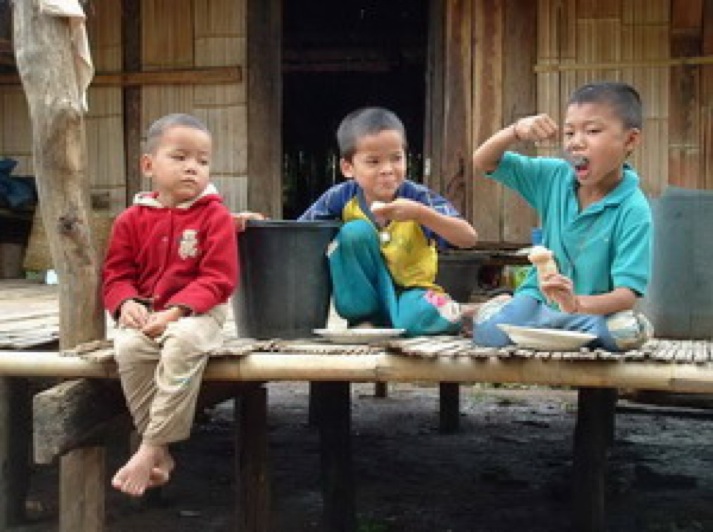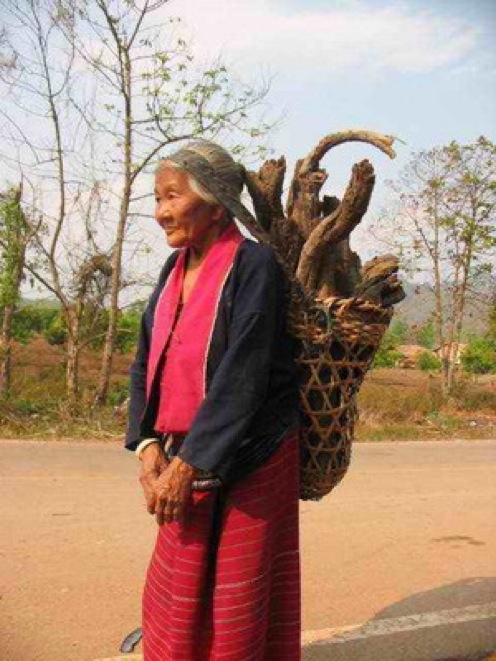By : Pu Chiangdao
Photo : Ongart Decha, Anuparb Nunsong
Paluang: forced to run from the land of war
“…Kon duk tu moeng ma
kruan pran tu moe roen
bae bee nong ga wai
bae bee nong ga wai…
We are the poor without field or farm
We are the poor with no money
Have mercy, have mercy…”
“Actually, Pangdaeng has a lot more to learn about…” Sakunee “Koy” Natpoolwat talked to me one night. Perhaps true. The woman felt for the fate of Pangdaeng villagers. She has been researching on the community together with other researchers at Chiang Mai University for several years.
Their research focuses on the struggle of villagers in Pangdaeng community, Tungluk sub-district of Chiang Mai’s Chiang Dao district. Several factors created this community. Politically, the villagers comprise ethnic groups that fled fighting in Burma. Economically, many villagers had moved into the community to work as wage labourers. They live under the enclosure of the state’s forest management policy, the extension of agricultural lands by the Khon Muang people, the pressure of a market system and competition with earlier settlers for access to natural resources.
“In order to understand why Pangdaeng villagers have been arrested time and again, we need to study the history of the Dara-ang people…,” said Sakunee.

Sakunee referred to a study in Burma which was recorded in James C. Scott’s famous “Gazetteer of Upper Burma and the Shan states” written in 1900. In this record, the Dara-ang or Palaung people were said to be the children of the king of the sun. They preferred to live in the uplands in the area of the Sun River, Northern Shan state. In a Dara-ang family, it is common to see different generations living together. They also had a reputation as great travellers. Later generations of Dara-ang also migrated to the southern part of Shan state in Kentung town. They developed good relationships with the ethnic Tai in Shan state.
The Palaung people are a Buddhist, peace-loving people, as Leslie Milne wrote in her 1910 work “Shan at Home.”
“Before British annexation, the Palaung’s neighbours, the Shan and the Kachin always engaged in fighting. However, the Palaung juggled between the two enemies paying tribute to both to continue to live under the conditions of war.”
This reflects the ability of the Palaung to adjust to the conditions and stress under which they live. So researchers have observed that the Palaung play less a role of active fighters than victims of war. Since the time of their ancestors, the Palaung have always been affected by wars; always on the run to escape invasions by other ethnic groups.
The Palaung of today live in great numbers in the north-western part of Shan State and parts of Kachin State in Burma, and in China’s southern Yunnan Province. In Thailand, they live in nine villages in Chiang Mai’s Fang, Mae Ai, and Chiang Dao districts.

“Why did the Palaung scatter in different directions?” someone asked when I returned once again to Pangdaeng.
“Because of the unending war…”
Perhaps this is the most likely answer you will get from any Palaung.
The old Palaung settlements in the eastern part of Shan State lay in the path of many military groups; the Burmese, Wa, Tai, and other ethnic minorities. The Palaung had no way to escape the effects of the war. Their houses were demolished by Burmese soldiers, their barns were burnt. They were robbed, their sons were abducted and forced to fight in the war, their daughters were raped. Fearful for their security, the villagers fled into the forest, sleeping on the ground and eating whatever they could find. They dispersed in all directions.
“When we were in Burma, we were forced to pay tax. We were ‘asked’ to help in the work of the Burmese soldiers, to work as porters, carrying rice sacks and food. If we refused, they barred us from working on our land.”
“We all feared the Burmese soldiers. There has always been fighting. In emergencies, the Burmese soldiers would ‘ask’ us to help fight their enemy. If we refused, they would force us.” Sakunee relayed stories she heard from the Pangdaeng villagers. Many times, she saw sorrow in their eyes; at other times their eyes were blank.
“When we lived in Doi Lai, there were many Burmese and Wa soldiers. We had to hide in the forest, sometimes for five or six months. They took away half our rice. It was dispiriting to working the land for the whole year and not have enough to eat. Sometime the soldiers came to ask for chillies or tua nao (fermented soybean). We lost our pigs, our chickens to the military groups,” Yod Lungmoeng told Sakunee.
Some Palaung people who used to live in the central and northern parts of Shan State walked four to five months across the mountains to reach the Thai border. Those living in Doi Lai, which is much closer to the border with Thailand, walked for three days and three nights without a rest. The exodus sometimes took over two weeks, with stops for the elderly and the young to catch up.
Some put into their mouths insects
Others substituted rice with leaves
To ease their hunger, to survive
Some became sick and died along the way
“There was no time for a proper burial. We just covered the corpses with banana leaves, and hurried on with our escape. The Burmese soldiers had threatened to do away with us if we didn’t move out of Doi Lai ,” uncle Kham Jongtal recalled sadly why the Palaung had to migrate to the Thai border.

During 1980-1981, when the Palaung first came to settle in villages along the Thai-Burma border in Chiang Mai’s Fang district, they developed good relationships with Thai soldiers and other hill ethnic minority people in the area. However, they continued to live in difficulty as the area was under the influence of the Shan drug lord Khun Sa, whose soldiers forced them to work in their fields and grow poppies.
In 1982, the Palaung refugees heard about the visit of His Majesty King Bhumipol of Thailand to Doi Ang Khang where the King was scheduled to meet Lahu villagers and other hill ethnic minorities residing in the Doi Ang Khang royal project. About 200 Palaung villagers planned to petition the King. They prepared a Buddha image, a tray of flowers, and Palaung clothing to be given to the King. This was to show their loyalty to the King and to show their similarity to the Thais in being Buddhist. Symbolically, the giving of the Palaung dress signified their submission as subjects under the rule of the Thai King.
Kham Jaiyod relates that the King asked the Palaung villagers who they were and if they were Buddhists. The Palaung then knew little Thai. They said their lives had been difficult. They wanted to reside in Thailand, to become Thai.
“The King said, so stay as you wish. He asked where we would like to live. We didn’t know what to answer because we didn’t know the area…,”
“The King allowed us to stay. He also gave 5,000 Baht to us to build a temple. We were very happy. We believed we could come to live in Thailand. We settled and built our village in the area which is now known as Ban Nor Lae.”
“…Adue ang grang raeng jor hor kam jai krue
Jor hor kam bueng moeng kun moeng rok doo e plan
La ba tan rok doo e don moey a mai kun moeng
Jorng ong man a due mai la ba tan koe ampoe
Joy ong rao tae yemoe due boi jo gon
We are the red-sarong Dara-ang
The Queen gives us clothes
The King rules the country
He loves the poor
He loves all ethnicities
We ask the Khon Muang to give us a village to stay in
We asked from the King and the district chief gave us lands
For us to live on peacefully and for our grandchildren too…”
That is the Ding song the Palaung people composed and sing until now.
However, wars continued on the other side of the border in 1982-1984. Many Palaung villages were burnt, and villagers lived in fear. How could their dream of a peaceful homeland become true in such a situation? With increasing violence, many more Palaung fled into Thailand.
“Before I left, I had just put rice into the barn. It was a good harvest, 600 buckets. But I had to leave to escape the Burmese soldiers in time,” said one Palaung man.
“Burma in war time is lawless. There were many powerful groups without clear rulers. They all competed for power and always fought each other. There was no peace like in Thailand. Here there is the King, a good administration, forest law. We know we won’t die of hunger here,” added another man.
Many Palaung villagers believe that they were allowed by the King to live in Thailand. Therefore, more and more Palaung refugees came from Doi Lai to live with their relatives in Ban Nor Lae. In order to survive, some villagers worked as wage labourers in tea plantations, lychee orchards and in the rice fields. They migrated to several areas within Chiang Mai province.
According official surveys, the Palaung or Dara-ang people live in nine villages in three districts of Chiang Mai: Ban Huay Wai Nok and Ban Huay Sai Khao in Mae Ai district; Ban Huay Janu, Ban Huay Mak Liem and Ban Nor Lae in Fang district; and Ban Mae Jon, Ban Huay Pong, Ban Pangdaeng Nok and Ban Thai Pattana Pangdaeng (Pangdaeng Nok) in Chiang Dao district.
The population of Dara-ang or Palaung people in Thailand is estimated to be about 5,000-7,000.

Anyone travelling in the northern part of Chiang Mai into Mae Ai, Fang and Chiang Dao districts will encounter people who dress distinctly. Men wear Tai-style, black or blue loose pants with long-sleeve t-shirts. Women wear hand-woven red sarongs with short, bright, long-sleeve blouses open at the front without ties or buttons. The blouse is usually decorated at the wrist with sequins, metal disks, and bright tassels. Women also wear a turban, but what catches visitors’ attention most are “nong ku” - hoops of silver or rattan they wear around their waist.
That is the Dara-ang or Palaung people, the ethnic group who fled war in Burma to reside in the peaceful land of Thailand.
Translated by Mukdawan Sakboon
Read More:
Pangdaeng…repeated nightmare (1)
Prachatai English is an independent, non-profit news outlet committed to covering underreported issues in Thailand, especially about democratization and human rights, despite pressure from the authorities. Your support will ensure that we stay a professional media source and be able to meet the challenges and deliver in-depth reporting.
• Simple steps to support Prachatai English
1. Bank transfer to account “โครงการหนังสือพิมพ์อินเทอร์เน็ต ประชาไท” or “Prachatai Online Newspaper” 091-0-21689-4, Krungthai Bank
2. Or, Transfer money via Paypal, to e-mail address: [email protected], please leave a comment on the transaction as “For Prachatai English”
